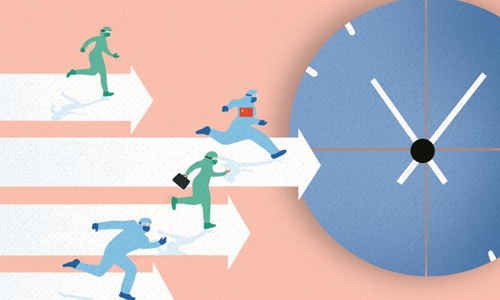HOME >> OPINION
Hindsight shows China took appropriate measures
By Hu Xijin Source:Global Times Published: 2020/3/17 21:28:41

Illustration: Liu Rui/GT
The outbreak of the novel coronavirus (COVID-19), which has now been classified as a global pandemic, has given us a chance to look back at what China had been through over the past weeks from a broad angle.
China started the battle against COVID-19 on January 20 when top Chinese epidemiologist Zhong Nanshan confirmed the coronavirus was capable of person-to-person transmission. The news shocked China. Three days later, Wuhan, Central China's Hubei Province, was locked down, which turned out to be a forward-thinking and decisive move in helping curb the spread of COVID-19.
Then the situation began to change every day. The Beijing municipal government announced on January 25 that long-distance buses traveling into and out of the capital city would be suspended from January 26. That was an important signal. On January 26, 1,975 cases of COVID-19 were confirmed across China, including 56 deaths.
If we turn the clock back to January 22, just before the lockdown of Wuhan, the number of confirmed infections was 571 with 17 deaths in the entire country. Based on such data, the Chinese government made major decisions including locking down Wuhan and mobilizing national resources to help Hubei.
On March 16, the UK reported 1,543 cases of COVID-19, with 55 deaths. The UK has a population of 66 million, which is slightly dwarfed by Hunan's 69 million. London has taken measures to fight against the coronavirus, but a half marathon in the city of Bath went ahead on Sunday despite an outcry against the holding of the event.
The Wuhan lockdown and level-one emergency measures adopted by various provinces put China on the frontline of the fight against COVID-19. The country's moves were not an easy call to make. Looking back hindsight, we are grateful for the Chinese government's determinations.
Except for China, the vast majority of countries failed to keep steps with the virus and responded negatively to the pending crisis. Some countries have now ramped up their epidemic prevention measures, and locked down cities, shut borders, canceled mass gatherings and closed restaurants and cafes. Spain has asked all its citizens to stay at home except for emergencies. These measures haven't worked well because they came too late.
Since late January, Chinese media outlets have been keeping a close eye on COVID-19 prevention and control in Wuhan. People suspected of contracting COVID-19 who couldn't get into a hospital made headlines. So did shortages of medical materials in the city. Now, Italy and Spain are facing the same problems that Wuhan has encountered.
Public dissatisfaction and Hubei's mismanagement were highlighted and timely responses were made. At the same time support from outside of Hubei have constantly come to Wuhan and Hubei. The People's Liberation Army sent its first medical team to Wuhan on January 24, which was the Spring Festival eve. The construction of Huoshenshan Hospital kicked off on the same day Wuhan was locked down. The hospital began to receive patients on February 3.
The first three Fangcang makeshift hospitals were completed on February 5, and 13 other were opened later. As the number of hospital beds increased, Wuhan spared no effort to make sure all patients who needed treatment were admitted to a hospital. This goal was realized on February 19, which was a turning point in the city's fight against the epidemic. It laid the solid foundation for the gradual decline in the infections in Wuhan and Hubei as well.
The biggest problem in Europe is the large number of infected people still living in communities without undergoing examinations and checks. Some countries have basically given up diagnosis and treatment for people with mild symptoms or suspected patients. Carriers of the virus are walking everywhere. No country in Europe dare say they are capable of treating every patient and there is no turning point in sight.
On February 4, the number of newly confirmed cases dropped for the first time in China outside Hubei. When the decline continued for days it became a trend and China saw a silver lining. Since then, more medical staff have been dispatched to Wuhan and Hubei.
During the epidemic fight, China has faced up to shortcomings in the country's social governance. For instance, some officials had been bureaucratic and formalistic in their press conferences, some community workers stormed into residents' apartment to stop them from gathering and playing mahjong, some failed to provide adequate services to local citizens while others took advantage of their power. These problems have been addressed timely and Chinese public opinions have played a role.
China started to slowly resume economic activities in mid-February, about 20 days after the lockdown of Wuhan.
More than 20 days have passed since the epidemic began to spiral out of control in Italy and experts still generally believe the peak of the pandemic in Europe has yet to arrive. What is worse, some experts predicted that tens of thousands of people will die from the virus. A most worrying thing is that people cannot see the turning point and are hoping warmer weather will bring a turnaround.
China's fight against COVID-19 realized the most fundamental pursuit of the people - bringing the epidemic under control. At the same time, the government has been responding to people's resentments on various issues with a positive attitude. China's efforts are not as bad as some people have imagined. There were indeed a lot of problems to be addressed and solved. But we must be realistic in our self-estimation but not improperly belittle ourselves due to these problems. This is the proper attitude we should take.
The author is editor-in-chief of the Global Times. opinion@globaltimes.com.cn
Posted in: VIEWPOINT